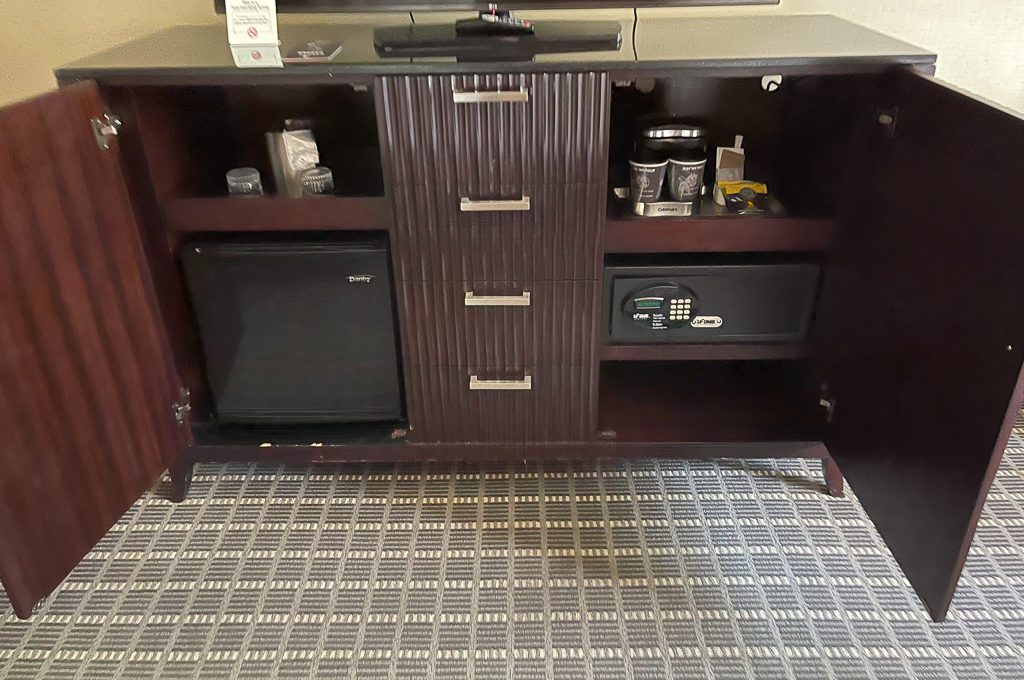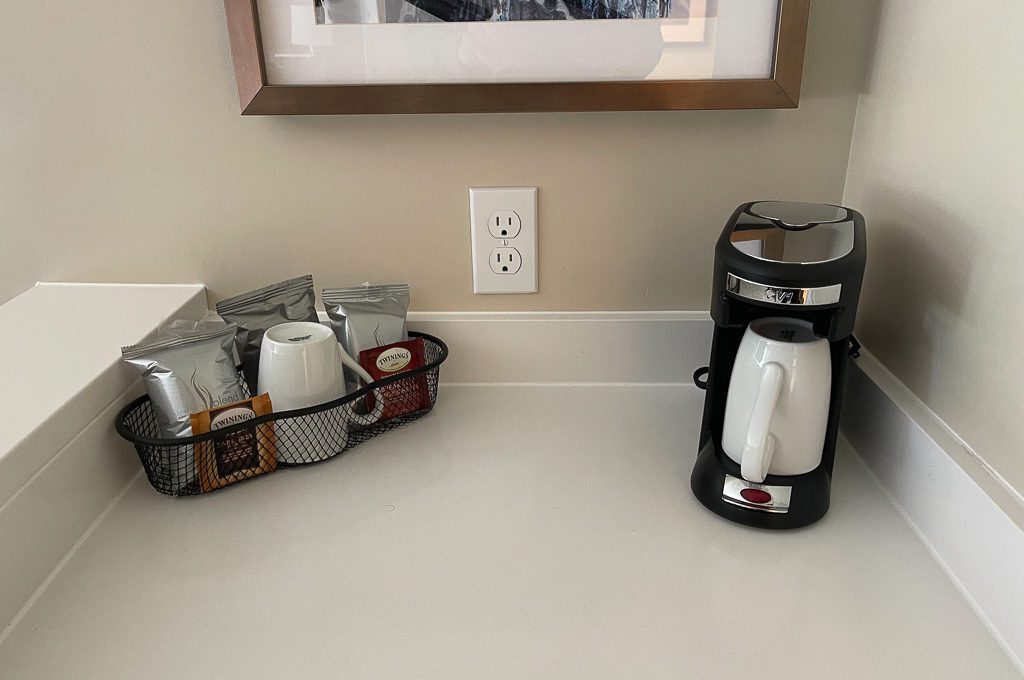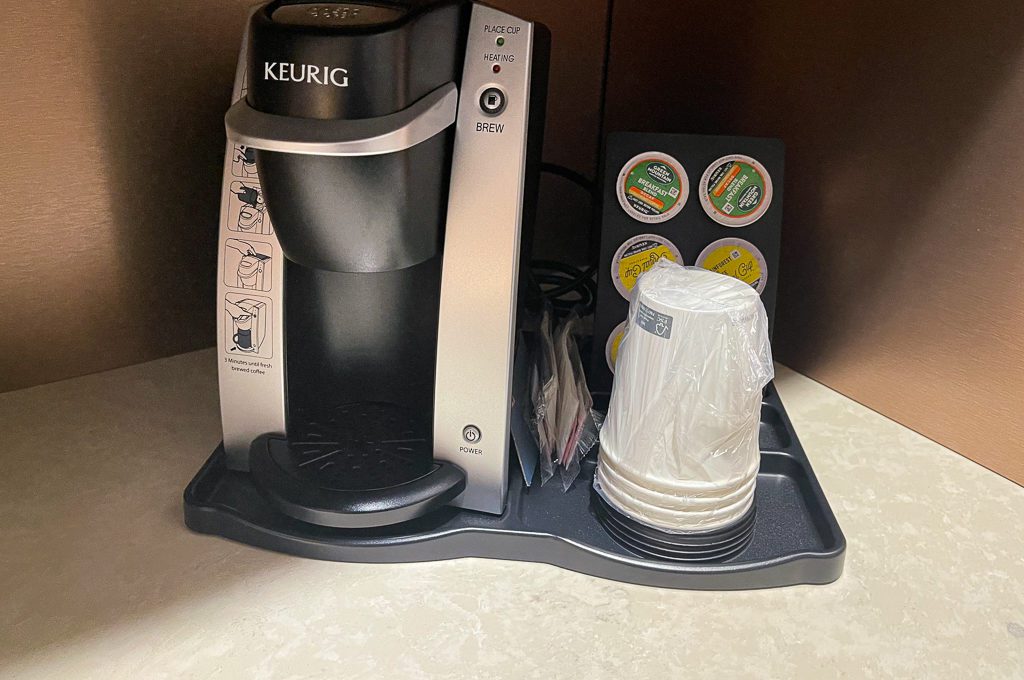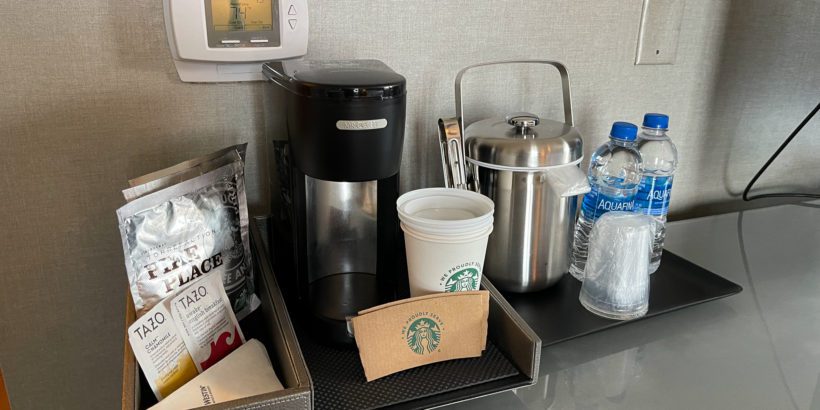You encounter them in pretty much every hotel room: coffee makers.
Common brands of these machines include Keurig, Cuisinart, and Mr Coffee.
They tempt you with a quick and easy solution to your caffeine fix but are these hotel room coffee makers sanitary and suitable for your coffee and/or tea?
In this article, I take a look to see if it is safe to use hotel room coffee makers and provide you with some insight and tips on the best way to go about it.
Tip: Use the free app WalletFlo to help you travel the world for free by finding the best travel credit cards and promotions!
Table of Contents
Are hotel room coffee makers clean and safe to use?
In general, hotel room coffee makers may pose health risks because many times they are not properly cleaned and by nature of their design they can easily collect bacteria and other harmful germs. However, you may be able to mitigate your risk by employing cleaning methods involving descaling (discussed more below).
Related: Is the Coffee and Tea in Your Hotel Room Free?
Why are hotel room coffee makers not safe?
You may have thought that because boiling water runs through these coffee machines that the risk of bacteria or other undesirable elements would be virtually eradicated.
But that does not appear to be the case.
First, Keurig coffee makers do not actually boil water. The maximum temperature comes out to 192° F which is well below the 212° F needed for boiling (at sea level). This is due to the optimal brewing temperature for coffee (which is sometimes lower than the optimal temperature for tea).
The good news is you don’t actually need boiling water to kill off many harmful substances according to Business Insider.
The bad news is that you need those high temperatures to be present for an extended duration to kill off these harmful substances and coffee makers may not be able to provide that.
Ultimately, the big concern is that the environment these coffee machines create is perfect for germs.
The reservoirs of coffee machines are dark, moist environments that allow mold to thrive. Furthermore, sometimes they are further tucked away in a dank drawer or cabinet area near a hotel safe, probably just making things worse.

Just how bad is the germ situation?
A 2011 NSF International Household Germ Study found that coffee makers in the home had more germs than bathroom faucet handles and toilet seats!
These germs included staph, coliform, and yeast and mold. Specifically, yeast was found in 50% of the coffee reservoirs of the coffee makers!
And that is at the home.
Do you think the average coffee maker in a home is cleaner or dirtier than one at a hotel?
Consider that hotel housekeeping is not going to spend a lot of time (or anytime) in a lot of cases deep cleaning the coffee makers. They may even neglect to clean the mugs which is one reason why you might want to bring your own disposable cups or mugs when traveling.

I sure would not bet on a coffee maker being as clean as one in your kitchen and would pretty much assume it is a breeding ground for all sorts of germs.
The other interesting thing about that study is that none of the volunteers placed a coffee maker in the top 10 when asked about the locations breeding the most germs.
So there is definitely a real disconnect between perception and reality when it comes to how filthy these coffee makers can be.
Coffee pot handles at breakfast
Not to crank up the fear meter but you should also be weary about using coffee pots in other places. If you are going for your morning coffee during your continental breakfast, you might want to think twice about grabbing the handle of the coffee pot without wiping it down.
Coffee pot handles are known to be breeding grounds for transporting viruses, so just try to use a little bit of caution when going for your coffee.
Related: What Hotels Have Free Breakfast?
How to clean the coffee maker
Instead of taking your chances of sipping mold and bacteria, a much safer way to consume coffee or tea during your hotel stay would be to properly clean the kettle first.
These coffee makers can come in different forms so the exact cleaning regime will vary based on the type of model that you are using.
But essentially the core process is the same.
The process you are going to attempt is called “descaling.”
Descaling should remove the chalky buildup of calcium and limescale which are both are non-toxic but can affect the functionality of the machine. But descaling can also remove mold, algae and bacteria.
(Note that white vinegar will not kill everything like streptococcus.)
In order to do descaling, first create a mixture of equal parts water and white vinegar. Then run that through the machine.
Once your cup is full simply pour out the mixture and then run another batch and repeat the process until you have emptied out all the mixture.
After that, run a cycle of water through the machine to further rinse it out. You may have to run a couple of water cycles in order to get the vinegar taste out.
Some people like to wait about 30 minutes between running the mixture through and rinsing with water but it is not clear to me that it is necessary to wait that long.
This process of running vinegar and water through a coffee maker (descaling) should be going on every couple of months for optimal cleaning.
However, as you would probably guess there are hotels out there that may go much longer than a couple of months before they run such a cycle. And some hotels and motels might be going years without doing this which results in a pretty significant build up of bacteria.
In addition to cycling a water vinegar mixture, you might also want to wipe down areas of the machine.
According to Chuck Gerba, professor of microbiology at the University of Arizona, one of the dirtiest areas of the coffee maker is the part of the machine where people place the plastic pod.
So if you have Lysol wipes you may want to wipe down all of the “high contact” points.
If you are dealing with a more complex coffee maker with multiple components then you might want to consider taking the whole thing apart and washing each piece thoroughly. This can involve a lot of work but if you are interested to see how it works check out this video.
Tip: It is worth pointing out that the ice buckets typically located near the coffee makers can also be problematic. If you are thinking about using one of these you surely want to give it a good scrub down.

Travel kettle
Personally, I don’t enjoy traveling with white vinegar and going through a cleaning process that may or may not remove the risk of getting exposed to whatever could be lingering in a hotel coffee maker.
My solution is to simply purchase a travel kettle. You can find these in a lot of different forms.
A lot of travelers like to go with the collapsible kettles. These flatten out like a pancake and can be easily stored in your luggage without having to worry about breaking glass or occupying a lot of space.
These are typically made of silicone and come with a stainless steel heating plate and lid. When flattened out they only occupy about 2 inches in height and about 5 inches across.
You can also find containers that can be heated, allowing you to boil water on the go.
I would generally try to avoid purchasing a travel kettle made of glass because of the risk of breaking it. If you do go that route, try to keep it in your carry-on so that you can control how it is handled.
Tip: If you are not able to clean your coffee maker and you don’t have a travel kettle, you can always call the front desk and ask them if you can borrow a kettle. This is very hit or miss but some hotels will happily lend you one during your stay.
Final word
Based on the data out there, the reservoirs in coffee makers can be breeding grounds for all sorts of germs including yeast and mold. In some cases, you might be better off boiling water out of your toilet. Okay, that might be a stretch but seriously I would recommend to avoid using coffee makers in hotel rooms. Try to find a portable kettle you can bring along with you and get by with that so that you can avoid everything lurking in the coffee maker.
Daniel Gillaspia is the Founder of UponArriving.com and the credit card app, WalletFlo. He is a former attorney turned travel expert covering destinations along with TSA, airline, and hotel policies. Since 2014, his content has been featured in publications such as National Geographic, Smithsonian Magazine, and CNBC. Read my bio.


Thank you for this article. I had no idea! I love your articles! Very interesting and thorough.:) I am going to buy a coffee pot that collapses to travel with from now on.
Thanks. A collapsible kettle has been one of my favorite all time travel purchases!
Thanks for this article. One thing I always wonder is when people have their second cup, how many of them – my husband included – refill the reservoir with their dirty cup/mug. Yuck!!! I can’t drink hotel or Airbnb coffee anymore. I can’t find mention of this unsanitary practice anywhere in online searches. Am I the only person who has thought of this?